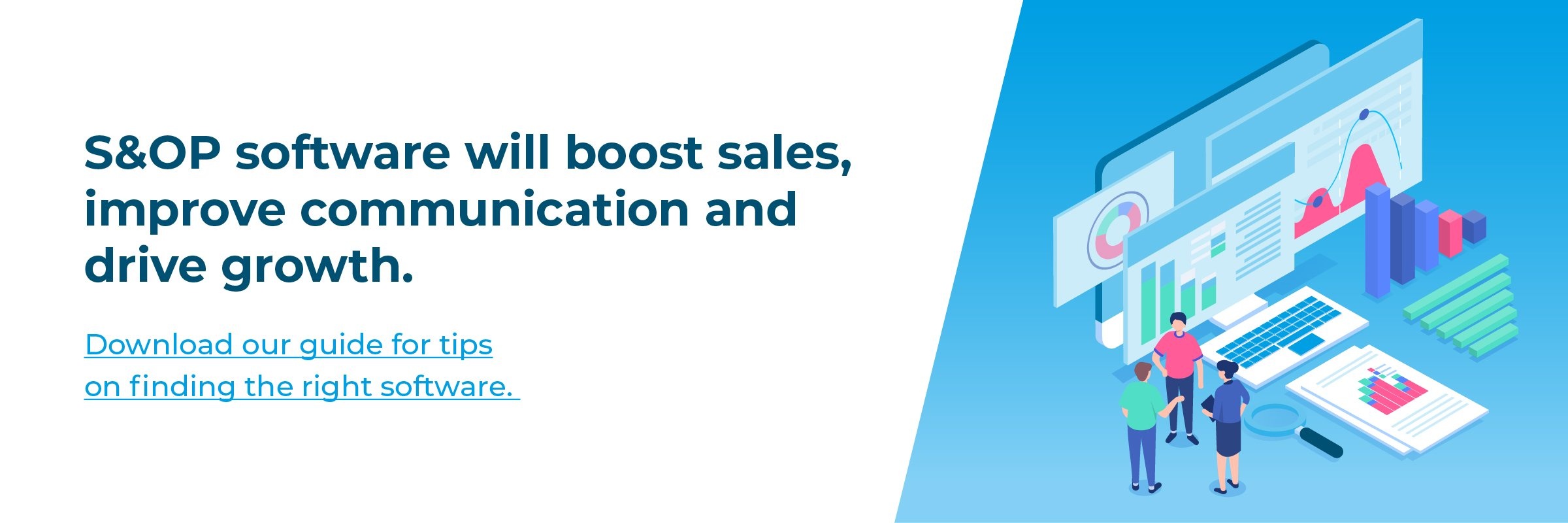An efficient and integrated sales and operational planning (S&OP) process is incredibly important for the future of business operations. Evolving demands and varying degrees of volatility can affect a business in negative ways, disrupting supply chains and other key business processes.
What does a good S&OP process look like and are there any common myths that need dispelling?
- What is S&OP?
- Are there any common S&OP myths?
- How Connected S&OP Improves the Process
- What does good S&OP look like?
WHAT IS S&OP?
S&OP aims to integrate supply and demand planning in your business. It provides better agility, response times and protection from volatile markets, uncertainty and other external influencers of our modern economy.
By connecting people, plans and data across your company over one universal platform, the decision-making process can be enhanced to account for future variables. By constantly forecasting and optimising your business plans, supply chain management and demand planning can act confidently in allocating resources to satisfy the needs of customers whilst maximising profit margins.
ARE THERE ANY COMMON S&OP MYTHS?
There are a number of common S&OP myths that we’d like to set straight.
1. The speed that supply chains move at means companies don’t have time to plan continuously
This is a real issue for a lot of companies who find it difficult to adjust and communicate changes to plans as market conditions evolve. It takes too much time to adjust plans and teams that are affected are not always aware of the change and are forced to react to keep up.
However, this is because they don’t have the right S&OP platform in place to plan effectively for their needs. The relevant, helpful technology to solve these challenges exists today. The only issue is people are yet to discover just how helpful it is.
2. An S&OP process doesn’t need a software platform to succeed
Most organisations hold data in multiple systems and use complicated spreadsheet models to bring data together for planning. It is common for complex spreadsheet models to be subject to key man dependency, that other team members are unable to access or even afraid to make a change in case they break them.
While an S&OP process can survive using these outdated, non-integrated formats, they’re far from ideal. They may even post a serious risk to the business as tracking and processing data manually is time-consuming, inefficient and prone to human error. And most important of all, spreadsheets hinder effective collaboration across teams.
By utilising fit for purpose S&OP software which was specifically designed with integrated planning in mind, whatever process you have in place is likely to be greatly enhanced. Connected Planning software promotes transparency across your business through a common platform that everyone can use to collaborate effectively in real-time.
For example, at Carters, a leading retailer of young children’s apparel, they’ve begun to use connected S&OP, which has led to an improvement in their ability to forecast capacity. From this, they’ve gained a reduction of expediting expenses as well as identifying opportunities for improving service levels.
3. Spreadsheets allow for effective S&OP modelling
International economies and markets are subject to constant change. Spreadsheets are, by their nature, static.
Keeping spreadsheet data up-to-date depends on human processing and manipulation. This is slow and can compromise your organisation’s ability to act in situations that call for a faster, more dynamic response.
Spreadsheets are not redundant, far from it, but they’re not up to the task of supporting planning in complex, ever-changing environments. They are inadequate when it comes to continuous re-forecasting and what-if scenarios.
HOW CONNECTED S&OP IMPROVES THE PROCESS
The S&OP process can seem complicated at first, but it’s not necessarily a difficult set of actions. There are six steps:
1. Product review
This step involves reviewing product pipelines and the overall health of products currently in the market to make decisions about how products are managed throughout their lifecycle. These decisions may cover:
- New production dates.
- Resource allocation.
- Prioritising projects.
2. Demand review
During this step, statistical forecasting is combined with both customer input and marketing plans to arrive at a demand plan. The factors that influence this can be multiple:
- Product introduction.
- Marketing plans.
- Consumer trends.
- Product hierarchy.
Historical performance and data will also be factored into this demand review for greater accuracy. This can be used to find gaps in revenue when compared to the finance review.
3. Supply review
Your supply plan and your demand plan work best when they work in unison.
By using a platform that can utilise real-time data, ‘what-if’ scenarios can be developed and combined with a baseline production plan. This helps to balance customer service and reduce both your operating costs and inventory.
4. Finance review
During this step, a month of S&OP processes is analysed using the previous month’s financial performance. Throughout the finance review, budgets and forecasts are compared with costs to forecast for the future. This helps to produce the baselines an organisation will work from, in which they can make adjustments to the previous three steps.
5. Pre-S&OP
The purpose of this step is to identify gaps and disconnects in your business’ framework by holding meetings for leaders of various departments. By using an S&OP software, you’ll be able to carry out these meetings by using a single, centralised platform.
Metrics such as inventory, revenue and profit are analysed by viewing the business as a whole - from the corporate level to the product line.
6. Executive S&OP
This is the final stage of the S&OP process - executive meetings that will bring together plans and data as well as ‘what-if’ scenarios and risks. Any issues that haven’t already been resolved in the previous steps can now be dealt with by viewing data and creating a collaborative, real-time response.
WHAT DOES GOOD S&OP LOOK LIKE?
The best sales and operational planning is highly inclusive and will support collaboration. For example, connected plans will flag up exceptions if changes in any part of the process are made. You may find that an unexpected result of a trade promotion will have a knock-on effect on your demand forecast for example. This exception will be flagged automatically to supply planning, that will drive collaboration to determine the appropriate action to be taken as the need arises.
Here is a summary of what good S&OP technology can provide for your planning team.
What-if scenarios
These types of scenarios can be run quickly to support key decisions. For example, you could increase production or slow down trade promotion. What-if scenarios provide insight into the possible effects of a variety of different options. The key issue here is speed. Answers need to be fast - in real-time to be useful for decision-makers.
Real-time visibility
The ability to collaborate on real-time data is key. A good S&OP process that includes real-time visibility across the sales and supply chain will enable your business to assess and collaborate to determine the best possible response quickly. Then you can take action at the right time to stay safely ahead of any market trends.
Includes executive support
To gain a fruitful outcome from an S&OP process, executive leaders should be directly involved. A CEO, president or managing director can provide key leadership input by making the final decision if teams struggle to agree. Having access to real-time information enables continuous oversight and a common understanding of the issues is immensely valuable to leadership in these situations.
Develops constructive problem-solving discussions
Any business process can produce disagreement between executives or departments. The ability to have transparent and constructive discussions is crucial when enhancing alignment across your company and developing operational plans.
An integrated S&OP process will enable you to discover any friction within the process. Many times, this can occur when there is a lack of participation from key people. Connecting planners across the process focus attention on key issues when required and drives collaboration when it is needed.
This helps to synchronise your efforts and ensure that key people remain engaged, aware and dedicated to delivering customer value, improving customer experience, appreciating market changes and ultimately developing growth.
Supports your business
A worthwhile S&OP software will be able to go beyond functional requirements and give you agile, dynamic reporting and decision-making advice. A successful S&OP software should solve business issues, not cause them.
Spreadsheets and traditional tools don’t support best practices, but the latest cloud-based technologies do. A cloud-based planning platform will provide a common set of data - ‘single version of the truth’ that supports effective real-time collaboration between teams. But where can you look for the right platform for you?
DISCOVERING THE BEST S&OP SOFTWARE FOR YOUR BUSINESS
To delve into the world of S&OP software, download our helpful guide. In it, you’ll be able to discover multiple software offers, their individual benefits and what to look for during your search.
You’ll also learn why S&OP is important for your business and the best tips on how to choose a platform.
Click the link below to download.

.jpeg)


